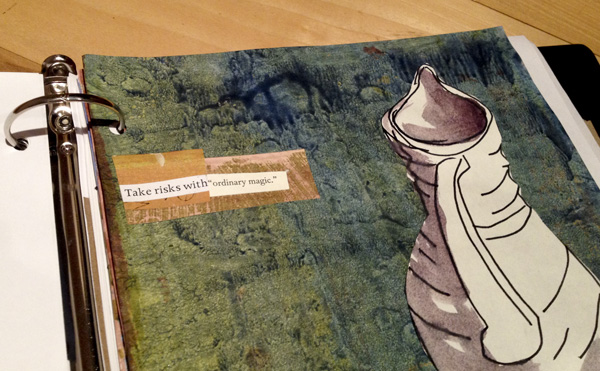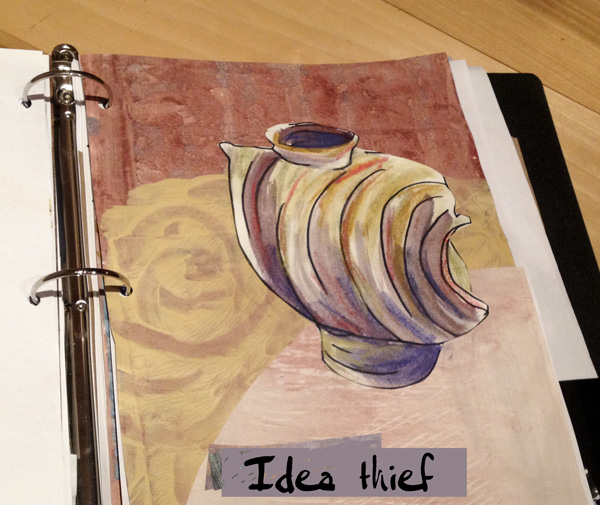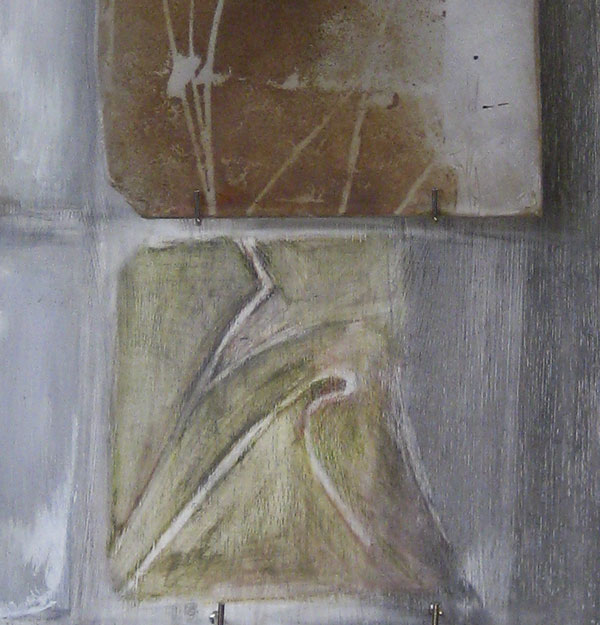 I am home again after teaching at Penland School of Crafts. My class was working in the upper clay studio and its goal was to fire the wood kiln. The pace of a two week session is very intense. We had to make all the work in the first week so that we had time to dry, fire, and cool the kiln before the end of the session. My concept was that we would make enough work to fill the kiln, fire it and get into a rhythm of producing drawings, collages, and notes. I hoped to give the students a recipe for working and a process for digesting and developing their own ideas.
I am home again after teaching at Penland School of Crafts. My class was working in the upper clay studio and its goal was to fire the wood kiln. The pace of a two week session is very intense. We had to make all the work in the first week so that we had time to dry, fire, and cool the kiln before the end of the session. My concept was that we would make enough work to fill the kiln, fire it and get into a rhythm of producing drawings, collages, and notes. I hoped to give the students a recipe for working and a process for digesting and developing their own ideas. Back in my studio, unpacking tools, pots, and notebooks, I am trying to assemble my experience of the session into some kind of order. For me that means drawing and collaging. While collating the paper shards into one notebook I am drawing not only what I made, but also what I imagined making and what my students attempted.
Back in my studio, unpacking tools, pots, and notebooks, I am trying to assemble my experience of the session into some kind of order. For me that means drawing and collaging. While collating the paper shards into one notebook I am drawing not only what I made, but also what I imagined making and what my students attempted.Roosting in my own house where my husband and I--as well as the dog--walk and talk in small circles, it is a stark contrast to Penland's variety of studios and the large circular tables of the Pines dining hall. While we are also in rolling hills, the vistas of the North Carolina valleys are steeper and mountains feel deeper; the momentum of such varied studios making disparate objects was energizing.
 At one dinner I asked Chris Benfey, the session bridging writer-in-residence, what he was working on. Chris said he had been re-reading The Jungle Book by Kipling and was tussling with the difference between when Mowgli is kidnapped by the monkeys versus his adoption in the wolf family. He was curious as to how Kipling manipulated our allegiance to the wolves and our agitated antipathy to the more human-like primates. On my drive back to Virginia I thought about how the Japanese had invaded Korea in the very late 1500s and kidnapped whole villages of Korean potters. The Japanese have had a long history of adapting Chinese ideas and making them their own, but in this instance the so-called pottery wars led to a Korean infusion into Japanese aesthetics, the discovery of porcelain and fundamental alterations to various ceramic traditions.
At one dinner I asked Chris Benfey, the session bridging writer-in-residence, what he was working on. Chris said he had been re-reading The Jungle Book by Kipling and was tussling with the difference between when Mowgli is kidnapped by the monkeys versus his adoption in the wolf family. He was curious as to how Kipling manipulated our allegiance to the wolves and our agitated antipathy to the more human-like primates. On my drive back to Virginia I thought about how the Japanese had invaded Korea in the very late 1500s and kidnapped whole villages of Korean potters. The Japanese have had a long history of adapting Chinese ideas and making them their own, but in this instance the so-called pottery wars led to a Korean infusion into Japanese aesthetics, the discovery of porcelain and fundamental alterations to various ceramic traditions.  I wasn't totally sure what to make of these conflicting concepts, but somehow it also resonated with another contrast discussed by Rachel Miller, the teacher of wearable sculpture. In her slide talk she contrasted the idea of a treadmill versus the labyrinth. Do we keep our hands making because we need the exercise or do we do it with thought and meditation? Does an external influence enhance our practice or do we just tramp along in our same old rut, stomping out new potentials without thought.
I wasn't totally sure what to make of these conflicting concepts, but somehow it also resonated with another contrast discussed by Rachel Miller, the teacher of wearable sculpture. In her slide talk she contrasted the idea of a treadmill versus the labyrinth. Do we keep our hands making because we need the exercise or do we do it with thought and meditation? Does an external influence enhance our practice or do we just tramp along in our same old rut, stomping out new potentials without thought. In my process of digesting my experience of teaching and firing, I ran across a note captured during one night of instructor images: "Idea thief." Often when I look at the work in a teaching studio after a well known artist visits, the pieces that students subsequently make seem like they have been generated from kidnapped tricks applied to their own materials and firing techniques. It occurred to me that what I want is for my students is to adopt ideas, not to kidnap them. I hope they have imbibed inspirations that motivate their own aesthetic path. Returning to their own studios I urge them to nurture new approaches to their materials, to cultivate their concepts for making and using objects, to reinvigorate their perceptions of form and perhaps to apply new theories for stacking and firing their kilns.
In my process of digesting my experience of teaching and firing, I ran across a note captured during one night of instructor images: "Idea thief." Often when I look at the work in a teaching studio after a well known artist visits, the pieces that students subsequently make seem like they have been generated from kidnapped tricks applied to their own materials and firing techniques. It occurred to me that what I want is for my students is to adopt ideas, not to kidnap them. I hope they have imbibed inspirations that motivate their own aesthetic path. Returning to their own studios I urge them to nurture new approaches to their materials, to cultivate their concepts for making and using objects, to reinvigorate their perceptions of form and perhaps to apply new theories for stacking and firing their kilns. "For Benfey, ceramics also possesses the explanatory power of metaphor,
standing in for all artistic creation. It represents what people make of
places, literally and otherwise. Transitory wayfarers pause, grasp what
lies beneath their feet and form it into creations both utilitarian and
beautiful. The handle of a pot, he writes, 'marks the journey from one
world to the other; it is the suspension bridge from the world of art to
the world of use.' "
"For Benfey, ceramics also possesses the explanatory power of metaphor,
standing in for all artistic creation. It represents what people make of
places, literally and otherwise. Transitory wayfarers pause, grasp what
lies beneath their feet and form it into creations both utilitarian and
beautiful. The handle of a pot, he writes, 'marks the journey from one
world to the other; it is the suspension bridge from the world of art to
the world of use.' "
 A year ago today we left to visit our daughter in Florence Italy. Due to snow we got stuck in Paris for 24 hours. I made endless drawings of luggage, weary travelers, morning coffee and evening espresso. A year later I am happy to walk my same old circles at dusk, racing to get out before it is completely dark, content to return for warm bowls of leek and potato soup.
A year ago today we left to visit our daughter in Florence Italy. Due to snow we got stuck in Paris for 24 hours. I made endless drawings of luggage, weary travelers, morning coffee and evening espresso. A year later I am happy to walk my same old circles at dusk, racing to get out before it is completely dark, content to return for warm bowls of leek and potato soup.
 "But this morning, a kind day has descended, from nowhere,
"But this morning, a kind day has descended, from nowhere, "--a poem needs to have at its heart a transformation, a fire where whatever story within you is burned into something else."
"--a poem needs to have at its heart a transformation, a fire where whatever story within you is burned into something else." 



 "Art is Pattern informed by sensibility" Herbert Read
"Art is Pattern informed by sensibility" Herbert Read I remember when I was a student at Antioch University in Columbia Maryland I would tape newspaper to my wheel head and paint perfect circles as I turned my wheel on and off and held my hand steady. I was chasing an idea of perfection.
I remember when I was a student at Antioch University in Columbia Maryland I would tape newspaper to my wheel head and paint perfect circles as I turned my wheel on and off and held my hand steady. I was chasing an idea of perfection.


 Above is a close-up of the drawing; below is the inspiration for this series of plates & drawings.
Above is a close-up of the drawing; below is the inspiration for this series of plates & drawings. 